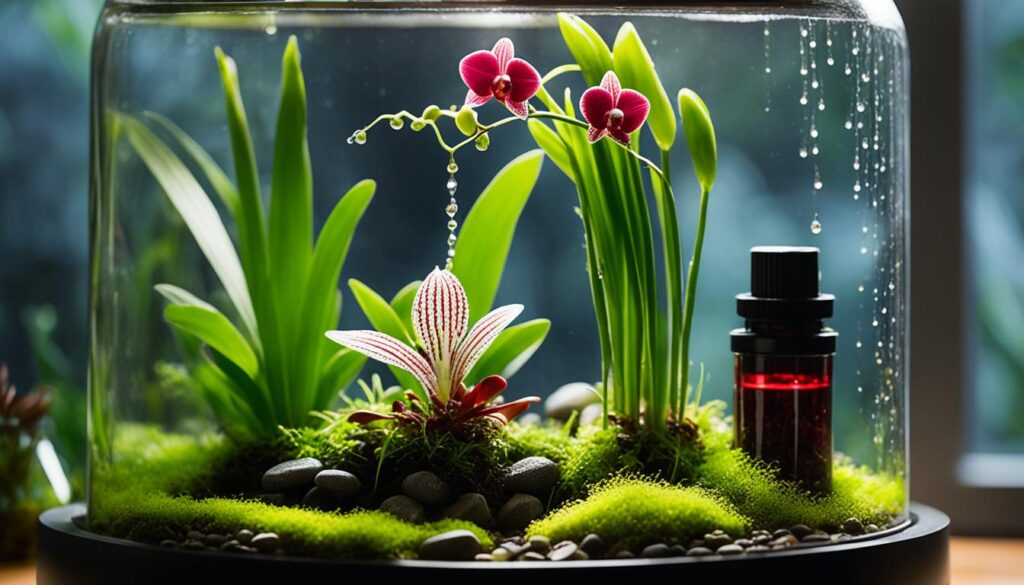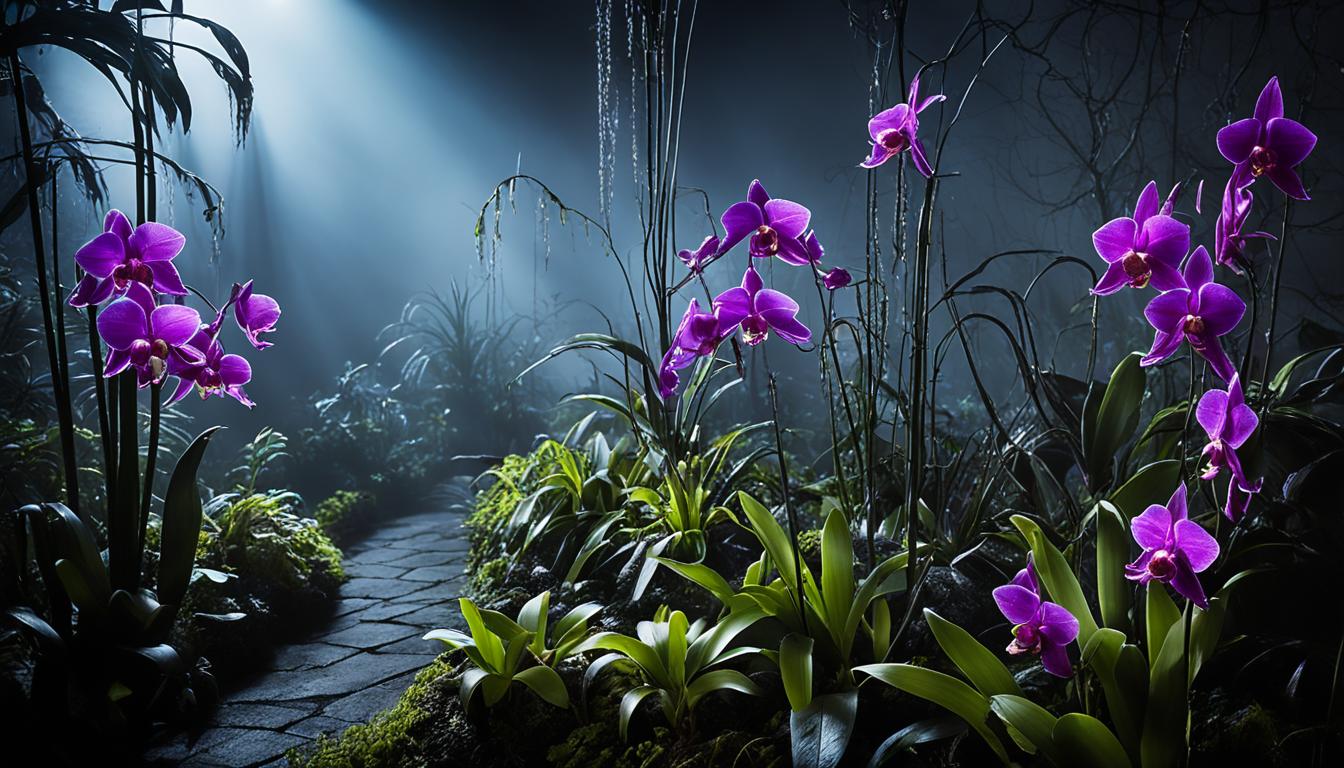With a name as intriguing as the vampire count himself, Dracula orchids are a botanical curiosity that only true plant aficionados might know. In a realm where common houseplants dominate, these lesser-known marvels thrive under the radar, with roughly 120 species lurking in the shadows.
Quick Facts
| Characteristic | Detail |
|---|---|
| Countries of Origin | Primarily found in the cloud forests of Central and South America, especially Ecuador and Colombia. |
| Colors | Varied, including red, brown, white, and green, often with intricate patterns or spots. |
| Size | Small to medium, with characteristic long, trailing inflorescences. |
| Difficulty To Grow | High; requires specific conditions of high humidity, cool temperatures, and low light. |
| Bloom Season | Various; many species can bloom at multiple times throughout the year. |
| Light Requirements | Low; prefers shaded conditions similar to its native cloud forest habitat. |
| Watering Needs | High; requires consistent moisture and high humidity without waterlogging. |
| Temperature Range | Cool to intermediate; generally prefers temperatures between 50-70°F (10-21°C). |
| Potting Medium | Well-draining and airy; often a mix of sphagnum moss and fir bark or mounted on cork. |
| Propagation Methods | Division, particularly when repotting or when plants become overcrowded. |
| Common Pests and Diseases | Susceptible to rot if overwatered; watch for pests like spider mites and scale in low humidity. |
| Fragrance | Some species are fragrant, often with unusual scents. |
| Lifespan/Longevity | Can live for many years with proper care; individual blooms last a few days to a week. |
| Conservation Status | Some species are considered rare or endangered due to habitat loss and collection. |
| Unique Features | Named for their resemblance to a dragon (“Dracula” means “little dragon” in Latin); unique monkey-face-like flowers. |
Discovered back in 1870, they’ve since seduced botanists and hobbyists alike with their esoteric allure.
Unlike the sun-seeking flowers that grace most gardens, Dracula orchid plant care takes a walk on the wild side, these beauties shun the light, preferring the comforting embrace of the shade.
My journey into cultivating Dracula orchids began with a fascination for their otherworldly charm and has since transformed into an homage to the misty forests from which they hail.
Navigating the care of these enigmatic blooms isn’t for the faint of heart. Dracula orchid varieties demand precise conditions, often reminiscent of their native Andean cloud forests.
To coax out their ethereal flowers, one must provide a cool and humid sanctuary, a far cry from the average living room environment.
But fear not, for with the right blend of perseverance and dedication, these night-time sentinels can become mesmerizing additions to your collection of houseplants.
And the reward? A glimpse into a darkly beautiful world that defies the ordinary and enchants with every petal.
For those willing to voyage beyond the commonplace, cultivating Dracula orchids represents a sublime blend of horticulture and artistry.
It invites us to explore the less-trodden path, to foster growth in the shade rather than the sunlight, and to revel in the enigmas that nature has to offer.
So, let’s embark on this trek together, unraveling the mysteries of these extraordinary orchids, and learning to nurture the beauty of the night right in our own homes.
Key Takeaways
- Dracula orchids are unique houseplants that shun the sunlight, thriving in shade and cool conditions.
- There are about 120 Dracula orchid varieties, each with peculiar shapes and care needs.
- Cultivating Dracula orchids requires recreating their natural habitat, with high humidity and specific temperature ranges.
- Dracula orchid plant care involves thoughtful watering, avoiding direct sun, and using moss to retain moisture.
- Though not for casual growers, these orchids offer an exotic experience and stunning blooms for dedicated enthusiasts.
Discovering the Elusive Dracula Orchid
Embarking on the journey to understand the elusive Dracula orchid species, I find myself compelled by their need for particular growing conditions.
Their striking appearance and complex growth patterns suggest that providing comprehensive Dracula orchid care instructions is crucial for any aspiring collector or enthusiast.
Ranging from their strikingly unique look to the precise maintenance they require, each aspect of the Dracula orchid growing guide is worth delving into.
The Enigmatic Origins and Taxonomy
I often marvel at the mysteries of the plant kingdom, especially species with cryptic origins.
Among them, Dracula orchids stand out as enigmatic wonders, settling slyly in the misty altitudes and demanding precise environmental conditions.
Their distinct absence of pseudobulbs marks a departure from typical epiphytes and hints at their unique symbiotic relationships within their habitat.
Rare and Alluring Species Variety
In the realm of these shadowy blooms, a fantastic array of species exists, each alluring and singular in form.
These are not your everyday orchids; the Dracula genus boasts a fascinating variety of species, each with its own individual allure.
Uncovering the secrets to their thriving growth is part of the fascinating quest to tend these marvels of nature.
Ecosystems: From Colombia to Your Home
It takes a patient and diligent gardener to emulate the native ecosystems of these orchids. It’s not merely about providing shade;
it’s about replicating the cool, humid conditions of their cloud forest homes.
As I’ve learned Dracula orchid maintenance, it’s become abundantly clear that the balance of moisture and nutrients is nothing short of an art form.
Unveiling the Mysterious “Monkey Orchid”
With a smile painted by nature’s own brush, the “Monkey Orchid” is a term affectionately ascribed due to its labellum’s simian semblance, a feature that nature devised to attract its fly pollinators.
Unveiling the mystery behind the captivating display of these Dracula orchids provides insights into the complex interplay between plants and their pollinators in the wild.
Below is a table that simplifies the essential factors for successful Dracula orchid care:
| Factor | Dracula Orchid Requirement |
|---|---|
| Light | Part to full shade (mimicking cloud forest canopy) |
| Moisture | High humidity and consistent moisture levels |
| Soil Composition | Sphagnum moss to retain humidity |
| Propagation Method | Seed propagation in flasks (for experienced growers) |
Maintaining these wondrous orchids can be as rewarding as it is challenging, providing an intimate glimpse into one of nature’s most intriguing floral phenomena.
Dracula Orchids: Care and Cultivation Secrets
When it comes to the alluring yet demanding Dracula orchid, I’ve learned that moisture is the secret to success.
These exotic plants are like those cool, mysterious characters in stories that captivate you with their uncommon habits.
Growing them at home might seem like a chapter out of a fantasy book, but it’s pretty doable with the right dracula orchid care tips.

The key to unlocking the potential of these plants lies in replicating their cloud forest home.
You won’t need a crystal ball, just some sphagnum moss instead of the regular bark mix to make your Dracula orchids happy.
Remember, these orchids don’t just want moisture; they thrive in it.
So, you’ve got to be consistent with the humidity, mimicking that mountain fog they love so much.
I’ve noticed that these plants aren’t just picky about their “climate”—the pots they live in can make or break their spirit.
A switch from your standard pot to something more breathable, like wooden baskets or terracotta pots, provides that essential airy environment, helping to avoid the dreaded root rot.
So, when you’re preparing their abode, think “airy castle” rather than “cozy cottage.”
Even the best of us gardeners can get a bit lazy, but repotting your Dracula orchid is not something to snooze on.
Doing this every two years, give or take, is like giving your orchid a new lease on life. Trust me, they silently thank you with their dramatic blossoms.
Dracula orchid plant care tips often make it sound like you need a magical touch, but the truth is, they need a gardener with a watchful eye and a tender touch.
If you’re up for the challenge, these moody beauties will show their appreciation with blooms that are nothing short of extraordinary.
Remember, it’s not just about maintaining life, it’s about achieving a slice of the untamed wilderness, right there in your living room.
Conclusion
As I wrap up this journey into the depths of the Dracula orchid’s domain, my appreciation for its intricate charm has only deepened.
These orchids are more than just plants; they’re living pieces of art, each carrying a slice of nighttime elegance.
The delicate interplay of caring for such an extraordinary species has shown me that the real beauty of gardening lies in the challenge it presents.
In nurturing these florae, I’ve not just been cultivating Dracula orchids; I’ve been preserving a part of the planet’s astonishing biodiversity.
Conserving the Night’s Mysterious Beauty
It’s our duty and delight to protect these shadowy beauties. Each Dracula orchid that blooms is a small victory, a sign that we’re on the right track with our plant care.
There’s a powerful satisfaction in knowing that through our efforts in cultivating these ornate flowers, we contribute to the continuity of their existence.
It gives a sense of purpose to wake up to a home with a corner dedicated to these mysterious blooms, it’s a reminder that the beauty of nature can thrive anywhere if only given the right care.
Embrace the Challenge of Dracula Orchid Care
I believe that every gardener should experience the thrill of nurturing something as unique as the Dracula orchid.
It’s not just about adding a beautiful specimen to your collection; it’s about the journey.
From learning the precise dracula orchid plant care to experimenting with their cultivation, each step is a learning curve that enriches your skills.
So, if you’ve got a yearning to bring a bit of the night’s mystique into your life, why not give these peculiar orchids a go?
Trust me, the rewards are well worth the effort.


Leave a Reply